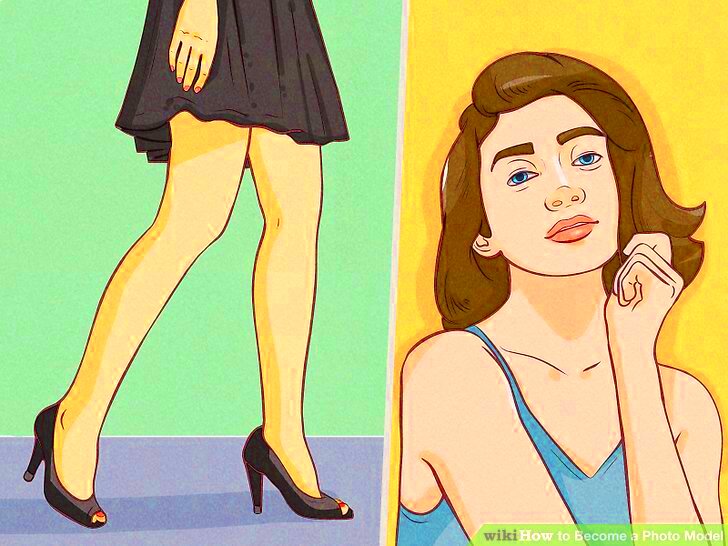Have you ever considered turning your pictures into a money making venture? Becoming a
Shutterstock model can be a fulfilling way to express your individuality and creativity while profiting from your photos. When I initially looked into this opportunity I was pleasantly surprised by its simplicity. It mainly involves grasping some fundamentals getting your portfolio ready and adhering to the submission guidelines.In this article I'll share my personal experiences and insights on how you can navigate this thrilling prospect. Whether youre an experienced photographer or a beginner this could be the ideal path for you.
Understanding Shutterstock's Requirements for Models

Before diving into modeling for
Shutterstock it's important to grasp the platforms expectations.
Shutterstock has guidelines in place to maintain the quality and legality of the content submitted. Lets take a closer look at the details.
- Model Release Forms: You need to provide a signed release form for any recognizable people in your photos. This ensures that Shutterstock has permission to use their likeness.
- High-Quality Images: Photos should be clear, well-lit, and high resolution. Avoid over-editing; natural, authentic images are often preferred.
- Content Guidelines: Ensure your content complies with Shutterstock’s content guidelines. Avoid sensitive or controversial topics and aim for inclusivity.
At the beginning I took the time to go through those requirements and thoroughly inspect my pictures. Believe me putting in some effort into the finer points can really impact the approval journey.
Steps to Create a Compelling Model Portfolio

To make your portfolio stand out and grab attention follow these tips on how to create an eye catching portfolio.
- Show Diversity: Include a variety of shots that showcase different moods, styles, and settings. This shows your versatility and appeal to a broader audience.
- Highlight Your Best Work: Quality over quantity. Choose photos that demonstrate your strengths and creativity. Each image should tell a story or evoke a feeling.
- Professional Presentation: Organize your portfolio neatly. Use high-quality images, and ensure they are well-categorized. This helps potential buyers find what they're looking for quickly.
- Update Regularly: Keep your portfolio fresh by regularly adding new images. This keeps your profile active and engaging.
Based on my experience, regularly refreshing my portfolio and prioritizing quality has accelerated my progress. Keep in mind that your portfolio serves as a representation of yourself, so ensure it leaves a lasting impression!
How to Submit Your Photos to Shutterstock

Uploading your pictures to
Shutterstock is a simple task but it does demand careful consideration. I recall my initial experience of submitting my photos; it felt like finding my way through a labyrinth. To make it easier for you here’s a quick walkthrough:
- Create an Account: If you haven’t already, sign up for a Shutterstock contributor account. It’s a quick process, and you’ll be ready to start uploading in no time.
- Prepare Your Images: Ensure your images meet Shutterstock’s quality standards. This means high resolution, sharp focus, and proper lighting. Edit them carefully but avoid excessive filters.
- Upload Your Photos: Use the Shutterstock upload tool to add your images. You can do this through their website or desktop application. Drag and drop your files or select them from your folders.
- Provide Metadata: Add relevant keywords, titles, and descriptions to each image. Think about what potential buyers might search for. Accurate metadata helps your images get discovered.
- Submit for Review: Once uploaded, your images will be reviewed by Shutterstock’s team. This can take a few days, so be patient. You’ll receive feedback on your submissions via email.
When I began my journey I didn’t fully grasp how crucial metadata was. By incorporating specific and pertinent keywords I greatly increased the visibility of my images.
Tips for Getting Approved and Increasing Visibility

Getting your pictures approved and making them really pop can be tough. Based on what I've learned here are a few tips to boost your odds.
- Understand Shutterstock’s Standards: Familiarize yourself with their image quality and content guidelines. Adhering to these standards is crucial for approval.
- Focus on Trends: Pay attention to current trends and incorporate them into your photography. Images that align with popular themes often perform better.
- Enhance Your Metadata: Use descriptive, accurate, and relevant keywords. This helps buyers find your images more easily. Avoid generic terms and be specific.
- Engage with the Community: Participate in Shutterstock’s forums and read their blog. Engaging with other contributors can provide valuable insights and keep you updated on best practices.
I discovered that engaging in discussions and keeping up with the latest trends had a significant impact. The suggestions from the community assisted me in honing my strategy and enhancing my submissions.
How to Improve Your Chances of Success
To boost your odds of success on
Shutterstock its not solely about submitting top notch visuals. Its also about constantly evolving and learning. Here are some suggestions to consider:
- Learn from Rejections: If your photos get rejected, take it as a learning opportunity. Review the feedback provided and adjust your approach accordingly.
- Invest in Equipment: Quality equipment can make a big difference. Good cameras and lenses can help you produce better images that meet Shutterstock’s standards.
- Expand Your Skills: Keep honing your photography skills. Experiment with new techniques and styles to broaden your portfolio.
- Analyze Market Trends: Regularly check Shutterstock’s best-selling images and adjust your submissions to align with current trends and buyer preferences.
Based on what I’ve been through I’ve found that being proactive and constantly working on my abilities has led to noticeable advancements. While the process of becoming a successful
Shutterstock model is still underway I truly believe that with commitment and enthusiasm it’s something that can be accomplished.
Common Mistakes to Avoid as a Shutterstock Model
Starting out as a Shutterstock model can be exciting but it's also easy to fall into traps. I've experienced it firsthand and gaining insights from these blunders can spare you time and hassle. Here are a few missteps to steer clear of.
- Neglecting Model Releases: One of the biggest errors is forgetting to get signed model releases. Without these, Shutterstock can't use photos of recognizable individuals, which could lead to rejection.
- Poor Image Quality: Submitting blurry or poorly lit images can hurt your chances. Ensure every photo is high-resolution, well-composed, and free of distractions.
- Inadequate Metadata: Adding vague or irrelevant keywords can limit your images' visibility. Be specific and thoughtful with your descriptions and tags.
- Ignoring Trends: Failing to stay updated with current trends might mean missing out on popular themes. Regularly check what’s trending and align your work accordingly.
- Overlooking Feedback: Ignoring feedback from Shutterstock's reviewers can prevent improvement. Take their comments seriously and use them to refine your submissions.
During my formative years I encountered my fair share of blunders. I discovered that focusing on the nuances and being receptive to suggestions had a significant impact. Take note of these pitfalls to pave the way for your achievements.
Benefits of Being a Shutterstock Model
Becoming a model for Shutterstock goes beyond just earning money; it offers an opportunity for development in both your personal and professional life. Here are some reasons why this journey can be fulfilling,
- Creative Freedom: You get to express yourself through your photos. Whether it’s capturing everyday moments or artistic visions, your creativity takes center stage.
- Passive Income: Once your photos are uploaded and approved, they can generate income over time. It’s a way to earn passively from your creative work.
- Global Reach: Shutterstock is a global platform. Your work can be seen and purchased by buyers from around the world, expanding your audience beyond local limits.
- Skill Development: The process helps you hone your photography skills and understand market demands. It’s a great learning experience that contributes to your professional growth.
- Community and Networking: Joining Shutterstock opens up opportunities to connect with other photographers and creatives, sharing insights and experiences that can inspire and motivate.
In my view the advantages go beyond just making money. Its about evolving as an artist and reaching out to a larger audience. Seize these chances and allow them to enrich your artistic path.
Frequently Asked Questions
Here are a few frequently asked questions regarding the process of becoming a Shutterstock model along with responses that could provide some clarity:
| Question | Answer |
|---|
| Do I need professional equipment to start? | Not necessarily. While professional equipment can help, you can start with a good-quality smartphone camera. The key is ensuring your images are clear and well-composed. |
| How long does it take for photos to be reviewed? | It usually takes a few days for Shutterstock to review your submissions. Be patient and check your account for updates and feedback. |
| Can I sell the same photo on other platforms? | Yes, you can sell the same photo on multiple stock photography sites, as long as you adhere to each platform's guidelines. |
| What happens if my photo is rejected? | If your photo is rejected, Shutterstock will provide feedback. Use this feedback to improve your submissions and try again. |
These frequently asked questions tackle a few worries. If you have additional inquiries feel free to contact Shutterstock's support or explore their contributor resources. Staying informed makes it easier to navigate the process.
Conclusion
Starting the path to becoming a Shutterstock model can be an adventure with its ups and downs. It involves grasping the submission rules and crafting a portfolio that stands out. Each stage of the process teaches you something new. I’ve realized that persistence and a keen eye for details are crucial.Embrace the journey, take lessons from feedback and constantly improve your methods. The satisfaction of showcasing your talent and profiting from your creations makes all the hard work worthwhile. Keep in mind that every step you take gets you nearer to success in the realm of stock photography. Keep moving ahead and savor the artistic journey!
 Before diving into modeling for Shutterstock it's important to grasp the platforms expectations. Shutterstock has guidelines in place to maintain the quality and legality of the content submitted. Lets take a closer look at the details.
Before diving into modeling for Shutterstock it's important to grasp the platforms expectations. Shutterstock has guidelines in place to maintain the quality and legality of the content submitted. Lets take a closer look at the details. To make your portfolio stand out and grab attention follow these tips on how to create an eye catching portfolio.
To make your portfolio stand out and grab attention follow these tips on how to create an eye catching portfolio. Uploading your pictures to Shutterstock is a simple task but it does demand careful consideration. I recall my initial experience of submitting my photos; it felt like finding my way through a labyrinth. To make it easier for you here’s a quick walkthrough:
Uploading your pictures to Shutterstock is a simple task but it does demand careful consideration. I recall my initial experience of submitting my photos; it felt like finding my way through a labyrinth. To make it easier for you here’s a quick walkthrough: Getting your pictures approved and making them really pop can be tough. Based on what I've learned here are a few tips to boost your odds.
Getting your pictures approved and making them really pop can be tough. Based on what I've learned here are a few tips to boost your odds.
 admin
admin








